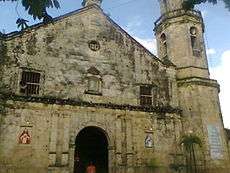Maasin Cathedral
Coordinates: 10°07′58″N 124°50′19″E / 10.1328°N 124.8385°E
| Our Lady of Assumption Cathedral of Maasin | |
|---|---|
 | |
| Basic information | |
| Location | Maasin, Southern Leyte, Philippines |
| Affiliation | Roman Catholic |
| Year consecrated | 1771 |
| Ecclesiastical or organizational status | Active |
| Heritage designation | National Historical Landmark |
| Architectural description | |
| Architectural type | Church building |
| Architectural style | Baroque |
| Completed | 23 March 1968 |
The Cathedral of Our Lady of the Assumption of Maasin (Spanish: Catedral de Nuestra Señora de la Asunción de Maasin), commonly known as the Maasin Cathedral is a baroque Roman Catholic church in Maasin, Southern Leyte, Philippines. The church is home to one of the oldest parishes of the country, the Maasin parish established by the series of waves of missionaries namely the Jesuits, Augustinians and finally, Franciscans.[1]
Originally built in 1700 by Jesuit priests, the church suffered several destruction and damage over the years, but has been rebuilt many times by the orders succeeding the Jesuits. Its present-day structure is constructed at 1968 and subsequently became the seat of the Roman Catholic Diocese of Maasin which covers the municipalities of Southern Leyte, including the towns of Matalom, Bato, Hilongos, Hindang, Inopacan and Baybay of province of Leyte.
History

Early records indicate that Maasin is one of the oldest towns in Southern Leyte. When the Spanish missionaries arrived there, they found the native population to be relatively organized, friendly and interested in the Catholic faith.[2] The Jesuits were the first order to formally establish a parish in the community in the 1700s. A piece of stone from a destroyed convent bearing the inscription "Pa. De Tagnipa - año 1776." authenticates the establishment. The ruins exist until the present time, lying between the border of Abgao and Mantahan districts.
Unfortunately, the province suffered heavily from the attacks of the Moro people's resistance against Spanish colonizers and the original church was destroyed in 1754. Following the departure of the Jesuits, the Augustinian fathers took over the parish in 1771 and ordered the construction of the second concrete church a kilometer away from the ruins of the first one.[2] This is the present-day location of the church. However, it suffered another extensive damage in the hands of the Moros on 1784. Another wave of missionaries came in 1843, this time the Franciscans, and they succeeded on establishing Our Lady of Assumption as the Patroness of the Parish on August 15. The people continued to celebrate August 15 as the town's official fiesta until the present time. The Franciscans managed over the ecclesiastical order until 1896 until they are forced to leave due to the revolution, which established the short-lived Philippine republic in the municipal government under the order of General Lukban. After the tumultuous events, a native clergy took over the church.[2]
By 1920s until 1930s, the parish was placed in the care of the diocesan priests of Cebu. It was then transferred to the Diocese of Calbayog and Diocese of Palo, until in 1968, it became the cathedral seat of the Diocese of Maasin on August 14.[1]
Features
The present design heavily borrows from the characteristics of baroque churches in the Philippines, with its traditional triangular pediment and simple facade punctuated by rectangular niches for the images and windows. However, a seemingly modern style was applied as shown by its rounded, three-layered bell tower which is a common feature among late 18th century churches.
References
- 1 2 Arlu, Edward. "Maasin City Cathedral: Standing with it's Beautiful History and Architecture". edwardlu.blogspot.com. Retrieved 21 October 2014.
- 1 2 3 "History of Maasin's Evolution". www.maasincity.com. Retrieved 21 October 2014.